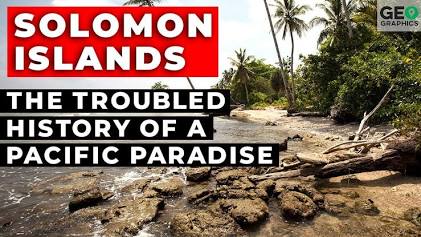 |
Explore the captivating timeline of the Solomon Islands, from prehistoric settlement and colonial domination to its pivotal World War II legacy and full independence in 1978. |
Uncover the historical journey of the Solomon Islands — from Melanesian roots and European colonization to WWII battles and independence. A Pacific history story rich in culture and global impact..................................
The Solomon Islands Timeline: A Chronicle of Cultural Resilience and Global Significance
Nestled in the South Pacific, the Solomon Islands — a chain of nearly 1,000 islands — holds a deeply layered and historically significant past. With early settlement dating back over 30,000 years, the islands have experienced major historical events, from ancient tribal culture and colonial encounters to the fierce Guadalcanal battles of World War II. Today, the capital Honiara symbolizes a nation that has journeyed through eras of change to become a sovereign state.
Let’s uncover this Pacific historical treasure by tracing its early inhabitants, colonial influences, wartime role, and modern emergence through this detailed timeline.
Ancient Origins and Early Settlers of the Solomon Islands
The early history of the Solomon Islands begins around 30,000 years ago when the first Melanesian settlers arrived from New Guinea and the Bismarck Archipelago. These early settlers established thriving communities, speaking unique languages and cultivating a rich cultural life that remains integral to the islands' identity.
✔ Around 1200–800 BCE, Austronesian seafarers, including the Lapita people, migrated into the islands. Known for their pottery and navigation expertise, they blended with Melanesian tribes, influencing agriculture and coastal trade. This historical fusion created diverse indigenous societies, many of which remain vibrant to this day.
✔ With social structures rooted in clans and chiefs, these communities developed oral traditions, spiritual beliefs, and maritime trade networks. Their navigational prowess connected them with surrounding island chains, marking one of the earliest inter-island exchanges in Pacific history.
European Contact: A Colonial Chapter in Solomon Islands History
The European discovery of the Solomon Islands occurred in 1568, when Spanish explorer Álvaro de Mendaña sailed into the archipelago. Mistaking the islands for the biblical land of King Solomon, he named them accordingly — igniting a new era of colonial curiosity.
✔ Although initial contact was short-lived, the 19th century saw increased European presence: traders, whalers, and missionaries arrived, altering traditional life and introducing foreign beliefs and practices.
✔ British and French missionaries particularly influenced religious transformation, spreading Christianity, building schools, and establishing clinics, leaving a lasting spiritual legacy.
✔ In 1893, the British Solomon Islands Protectorate was declared, primarily covering the eastern islands. Germany controlled the western regions until the 1899 Anglo-German Treaty, which granted full British authority — marking a defining colonial event in the Solomon Islands' timeline.
World War II: The Solomon Islands' Place in Global Conflict
A defining moment in the 20th-century history of the Solomon Islands came during World War II, when the islands became a strategic theater for the Allies and Japanese forces.
✔ The Guadalcanal Campaign (1942–1943), one of the most critical battles in Pacific wartime history, witnessed intense clashes between U.S.-led Allied forces and Japan. The campaign shifted the tide of the war in favor of the Allies and left an enduring legacy on the Solomon Islands.
✔ Countless relics — sunken warships, airfields, and war graves — remain as historical markers, drawing war historians and tourists alike. This period elevated the Solomon Islands' place in global wartime chronicles.
✔ The devastation and foreign presence during this time also sparked a growing awareness of national identity, laying the foundation for future demands for self-rule.
Steps Toward Independence: A Nation Reclaims Its Destiny
Following the war, decolonization movements swept the globe, and the Solomon Islands began its journey toward political autonomy. The establishment of a Legislative Assembly in 1964 signaled the first formal step toward governance.
✔ On July 7, 1976, the country achieved internal self-government, and just two years later, on July 7, 1978, the Solomon Islands celebrated full independence from Britain. This historic moment marked the end of over 80 years of colonial rule and began a new chapter in the independence timeline of Pacific nations.
✔ Sir Peter Kenilorea, a central figure in this transition, became the country's first Prime Minister. The Solomon Islands joined the Commonwealth and began to chart its own future as a sovereign state.
Key Historical Events in Solomon Islands History
Famous Historical Figures and Political Leaders
Modern-Day Challenges and Historical Impact
Even after independence, the Solomon Islands have navigated historical challenges like ethnic conflicts in the 1990s, most notably between Guadalcanal and Malaita groups. This unrest prompted the 2003 Regional Assistance Mission to Solomon Islands (RAMSI) — a multinational effort that restored peace and became part of contemporary history.
✔ The economy relies on natural resources (forestry, fisheries, and mining), while tourism continues to grow, fueled by interest in war memorials, coral reefs, and indigenous heritage.
Historic Facts at a Glance
- Region: Southwest Pacific
- Capital: Honiara
- Official Independence Day: July 7, 1978
- Languages: Over 70 indigenous tongues; English is official
- Currency: Solomon Islands Dollar (SBD)
- Population: Approx. 700,000
- Most Popular Traditional Drink: Coconut water
Conclusion: A Nation Built on History
The Solomon Islands stands as a beacon of Pacific resilience, shaped by waves of migration, colonial power shifts, war, and political rebirth. From the early footprints of the Melanesian settlers to the roaring battles of World War II and a triumphant independence journey, the nation carries a history both ancient and unforgettable.
Its story is a living timeline — where traditional songs echo alongside war relics, and indigenous pride walks hand-in-hand with modern aspirations. As the Solomon Islands looks ahead, its past will always illuminate the way forward.




